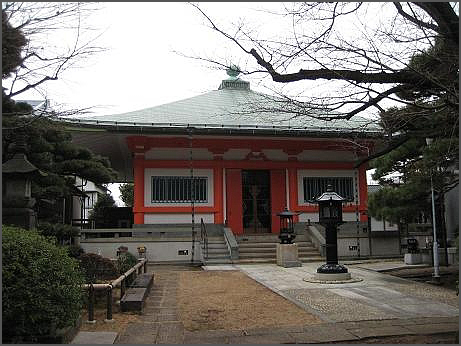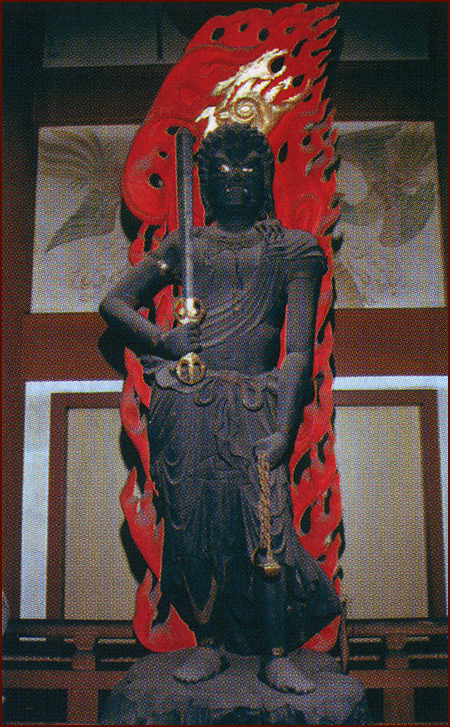[ . BACK to DARUMA MUSEUM TOP . ]
. Gofunai 御府内八十八ヶ所霊場 88 Henro Temples in Edo .
::::::::::::::::::::::::::::::
Nr. 06 - Fudoo-in 不動院 Fudo-In
- 五大山 Godaisan 不動院
港区六本木3-15-4 / Roppongi, Minato ward
Shingon Sect : 高野山真言宗

The origins of this temple are not clear.
The main statue is Fudo Myo-O 大日大聖不動威怒明王 .
麻布不動坂の一願不動さん
Azabu Fudozaka no Ichigan Fudo
also called
六軒町の目黄不動
Rokkenmachi no Meki Fudo - Fudo with Yellow Eyes
The date of its establishment is not quite clear, but it might have been relocated from 麹町平河町 Kojimachi Hirakawachoin 1658. It was moved to 麻布六軒町 Azsabu Rokkencho.
During the Edo period, 兒稲荷 Kabuto Inari in the compound was quite popular.
- ご詠歌 - chant of the temple 安楽寺 Anraku-Ji in Shikoku :
仮の世に知行争うむやくなり 安楽国の守護をのぞめよ
Kari no yo ni chigyōarasofu muyakunari anrakukoku no shugo o nozomeyo
- 朱印 - stamp of the temple :

- Homepage of the temple
- source : tesshow.jp/minato/temple_
..............................

. Fudō Myō-ō, Fudoo Myoo-Oo 不動明王 Fudo Myo-O
Acala Vidyârâja - Vidyaraja – Fudo Myoo .
. Ichigan Fudo 一願不動 One Wish Fudo Temples .
..............................

::::::::::::::::::::::::::::::
Nr. 07 - Shitsusenji 室泉寺 Shitsusen-Ji
- 源秀山 Genshuzan 永松院 Eisho-In 室泉寺 (シツセンジ)
渋谷区東3-8-16 / 3 Chome-8-16 Higashi, Shibuya ward
Shingon Sect : 真言宗

This temple was founded in 1700 by 快圓和上 on request of the fifth Shogun Tsunayoshi, in the ground of the estate of official 松平忠益 Matsudaira Sadamasu.
The main statue is 阿弥陀如来 Amida Nyorai.
The temple was first located in 芝金杉 Shiba and belonged to the 浄土真宗西本願寺派 Jodo Shinshu Sect.
In the hall 護摩堂 Goma-Do is a statue of 不動明王 Fudo Myo-O and one of 愛染明王 Aizen Myo-O.
They were made by the disciple of 南都招提寺開山 鑑真和尚, named 支卓律師.

- ご詠歌 - chant of the temple 十楽時 Juraku-Ji in Shikoku :
Ningen no hakku o hayaku hanarenaba itarankata wa kubon jūraku
人間の八苦を早く離れなば 到らん方は九品十楽
- 朱印 - stamp of the temple :

- hengaku 扁額 temple name plate -

- Homepage of the temple
- source : tesshow.jp/shibuya/temple
. Introduction of Amida Nyorai .

..............................
- - - - - #edohistory - - - - -
. hengaku 扁額 temple name plate .
::::::::::::::::::::::::::::::
- reference : 御府内八十八 不動院 -
- reference : 御府内八十八 室泉寺 -
::::::::::::::::::::::::::::::
- Koya San in Wakayama 和歌山 高野山 -
- Kobo Daishi Kukai 弘法大師 空海 (774 - 835) -
. Gyoki Bosatsu 行基菩薩 (668 - 749) Saint Gyōki .
. Shikoku Henro Temple List 四国遍路 .
. Gofunai 御府内八十八ヶ所霊場 Pilgrimage to 88 Henro Temples in Edo .
- Introduction -
::::::::::::::::::::::::::::::

. Join the Updates of Facebook ! .
::::::::::::::::::::::::::::::
. Japan - Shrines and Temples - ABC .
. Welcome to Edo 江戸 ! – The Edopedia .
[ . BACK to DARUMA MUSEUM . TOP . ]
[ . BACK to WORLDKIGO . TOP . ]
- - - - - @edopilgrims #edohenro #edofudoin #shitsusenji - - - - -
::::::::::::::::::::::::::::::
--
Posted By Gabi Greve to Gokuraku - Jigoku on 12/28/2016 01:39:00 pm













































